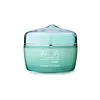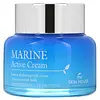What's inside
What's inside
 Key Ingredients
Key Ingredients

 Benefits
Benefits

 Concerns
Concerns

No concerns
 Ingredients Side-by-side
Ingredients Side-by-side

Water
Skin ConditioningGlycerin
HumectantCyclomethicone
EmollientDipropylene Glycol
HumectantHydrogenated Polydecene
EmollientNiacinamide
Smoothing1,2-Hexanediol
Skin ConditioningCetyl PEG/PPG-10/1 Dimethicone
EmulsifyingSodium Chloride
MaskingMagnesium Sulfate
Zinc Sulfate
AntimicrobialRosa Canina Fruit Oil
EmollientCitrus Limon Fruit Extract
MaskingMalpighia Punicifolia Fruit Extract
AntioxidantEuterpe Oleracea Fruit Extract
Sodium Hyaluronate
HumectantSargassum Fulvellum Extract
Skin ConditioningGelidium Cartilagineum Extract
Skin ProtectingCaprylic/Capric Triglyceride
MaskingButylene Glycol
HumectantChlorella Minutissima Extract
Skin ConditioningMacrocystis Pyrifera Extract
Skin ConditioningEnteromorpha Compressa Extract
Skin ProtectingLaminaria Japonica Extract
Skin ProtectingCaulerpa Lentillifera Extract
Aloe Barbadensis Leaf Extract
EmollientPropanediol
SolventGlycereth-26
HumectantEthylhexylglycerin
Skin ConditioningTriethanolamine
BufferingCarbomer
Emulsion StabilisingCaffeine
Skin ConditioningXanthan Gum
EmulsifyingDisodium EDTA
Parfum
MaskingPhenoxyethanol
PreservativeWater, Glycerin, Cyclomethicone, Dipropylene Glycol, Hydrogenated Polydecene, Niacinamide, 1,2-Hexanediol, Cetyl PEG/PPG-10/1 Dimethicone, Sodium Chloride, Magnesium Sulfate, Zinc Sulfate, Rosa Canina Fruit Oil, Citrus Limon Fruit Extract, Malpighia Punicifolia Fruit Extract, Euterpe Oleracea Fruit Extract, Sodium Hyaluronate, Sargassum Fulvellum Extract, Gelidium Cartilagineum Extract, Caprylic/Capric Triglyceride, Butylene Glycol, Chlorella Minutissima Extract, Macrocystis Pyrifera Extract, Enteromorpha Compressa Extract, Laminaria Japonica Extract, Caulerpa Lentillifera Extract, Aloe Barbadensis Leaf Extract, Propanediol, Glycereth-26, Ethylhexylglycerin, Triethanolamine, Carbomer, Caffeine, Xanthan Gum, Disodium EDTA, Parfum, Phenoxyethanol
Water
Skin ConditioningGlycerin
HumectantSodium Hyaluronate
HumectantButylene Glycol
Humectant1,2-Hexanediol
Skin ConditioningVinyldimethicone
Orbignya Oleifera Seed Oil
EmollientAmmonium Acryloyldimethyltaurate/Vp Copolymer
Potassium Olivoyl PCA
CleansingHoney Extract
HumectantSea Water
HumectantPearl Extract
AntioxidantBetaine
HumectantEcklonia Cava Extract
Skin ConditioningSpirulina Platensis Extract
Skin ProtectingEthylhexylglycerin
Skin ConditioningPyrus Communis Fruit Extract
Skin ConditioningRosa Damascena Flower Water
MaskingIris Florentina Root Extract
MaskingCucumis Melo Fruit Extract
Skin ConditioningHedera Helix Leaf/Stem Extract
AntimicrobialWater, Glycerin, Sodium Hyaluronate, Butylene Glycol, 1,2-Hexanediol, Vinyldimethicone, Orbignya Oleifera Seed Oil, Ammonium Acryloyldimethyltaurate/Vp Copolymer, Potassium Olivoyl PCA, Honey Extract, Sea Water, Pearl Extract, Betaine, Ecklonia Cava Extract, Spirulina Platensis Extract, Ethylhexylglycerin, Pyrus Communis Fruit Extract, Rosa Damascena Flower Water, Iris Florentina Root Extract, Cucumis Melo Fruit Extract, Hedera Helix Leaf/Stem Extract
Ingredients Explained
These ingredients are found in both products.
Ingredients higher up in an ingredient list are typically present in a larger amount.
1,2-Hexanediol is a synthetic liquid and another multi-functional powerhouse.
It is a:
- Humectant, drawing moisture into the skin
- Emollient, helping to soften skin
- Solvent, dispersing and stabilizing formulas
- Preservative booster, enhancing the antimicrobial activity of other preservatives
Butylene Glycol (or BG) is used within cosmetic products for a few different reasons:
Overall, Butylene Glycol is a safe and well-rounded ingredient that works well with other ingredients.
Though this ingredient works well with most skin types, some people with sensitive skin may experience a reaction such as allergic rashes, closed comedones, or itchiness.
Learn more about Butylene GlycolEthylhexylglycerin (we can't pronounce this either) is commonly used as a preservative and skin softener. It is derived from glyceryl.
You might see Ethylhexylglycerin often paired with other preservatives such as phenoxyethanol. Ethylhexylglycerin has been found to increase the effectiveness of these other preservatives.
Glycerin is already naturally found in your skin. It helps moisturize and protect your skin.
A study from 2016 found glycerin to be more effective as a humectant than AHAs and hyaluronic acid.
As a humectant, it helps the skin stay hydrated by pulling moisture to your skin. The low molecular weight of glycerin allows it to pull moisture into the deeper layers of your skin.
Hydrated skin improves your skin barrier; Your skin barrier helps protect against irritants and bacteria.
Glycerin has also been found to have antimicrobial and antiviral properties. Due to these properties, glycerin is often used in wound and burn treatments.
In cosmetics, glycerin is usually derived from plants such as soybean or palm. However, it can also be sourced from animals, such as tallow or animal fat.
This ingredient is organic, colorless, odorless, and non-toxic.
Glycerin is the name for this ingredient in American English. British English uses Glycerol/Glycerine.
Learn more about GlycerinSodium Hyaluronate is hyaluronic acid's salt form. It is commonly derived from the sodium salt of hyaluronic acid.
Like hyaluronic acid, it is great at holding water and acts as a humectant. This makes it a great skin hydrating ingredient.
Sodium Hyaluronate is naturally occurring in our bodies and is mostly found in eye fluid and joints.
These are some other common types of Hyaluronic Acid:
Learn more about Sodium HyaluronateWater. It's the most common cosmetic ingredient of all. You'll usually see it at the top of ingredient lists, meaning that it makes up the largest part of the product.
So why is it so popular? Water most often acts as a solvent - this means that it helps dissolve other ingredients into the formulation.
You'll also recognize water as that liquid we all need to stay alive. If you see this, drink a glass of water. Stay hydrated!
Learn more about Water